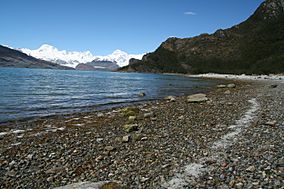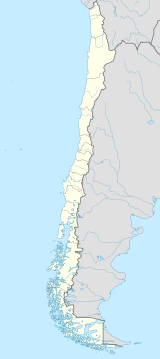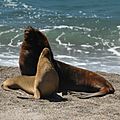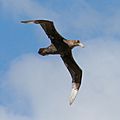Alberto de Agostini National Park facts for kids
Quick facts for kids Alberto de Agostini National Park |
|
|---|---|
|
IUCN Category II (National Park)
|
|

Marinelli Glacier
|
|
| Location | Magallanes Region, Chile |
| Nearest city | Punta Arenas |
| Area | 1,460,000 ha (3,607,739 acres) |
| Established | January 22, 1965 |
| Governing body | National Forest Corporation (Chile) |
Alberto de Agostini National Park is a special protected area in Chile. It was created on January 22, 1965. This huge park covers about 1.46 million hectares (that's like 3.6 million acres!). It's home to the Cordillera Darwin mountain range. These mountains are the very last part of the famous Andes before they disappear into the Pacific Ocean and the Beagle Channel as small islands.
In 2005, UNESCO named this park, along with Cabo de Hornos National Park, a Biosphere Reserve. This means it's a very important place for nature. UNESCO says the park has a "mosaic of contrasting ecosystems," which means it has many different types of natural areas that are unique in the world.
Inside the park, you'll find many amazing tidewater glaciers. These are glaciers that flow right into the sea. There are also steep fjords, which are narrow inlets of the sea between high cliffs. The park also includes several islands like Gordon, Cook, and Londonderry. Part of Hoste Island is also within the park's borders.
Contents
History of the Park
Who was Alberto de Agostini?
The park is named after Father Alberto Maria De Agostini. He was a very important Salesian priest from Italy. He was an explorer, photographer, and writer. He is famous for discovering new places, taking amazing photos, and making maps of this region.
Early Visitors and Discoveries
The area was visited by the famous scientist Charles Darwin. He met the native Fuegian peoples, like the Yaghan, who had lived along the Murray Channel for about 10,000 years. Darwin's meeting with these people was very important for his ideas about human evolution. Some parts of the park, like the beautiful Agostini Fjord, were only discovered in the last century.
A World Biosphere Reserve
In 2005, Alberto de Agostini National Park and Cabo de Hornos National Park were together named the Cabo de Hornos World Biosphere Reserve by UNESCO. This shows how special and important these natural areas are.
Where is the Park Located?
The park is located about 148 kilometers (or 80 nautical miles) southwest of Punta Arenas. Punta Arenas is the closest big city. The park is in the Magallanes y la Antártica Chilena region of Chile. It stretches across three different provinces: Magallanes, Tierra del Fuego, and Antártica Chilena.
Geography and Mountains
The park has a very uneven coastline with many deep fjords. The most important part of the park is the Cordillera Darwin mountain range. Its slopes drop sharply right into the sea. The Darwin range is dominated by two big mountains: Monte Darwin and Monte Sarmiento. Many valleys that are not filled by the sea are covered by glaciers. Glaciers also sit on small high plateaus.
Geology and Glaciers
Much of the park's landscape was shaped by powerful glaciers. The biggest glacier is the Marinelli. However, it has been getting smaller since 2008.
One of the most stunning parts of the park is the Seno Pía. This is a large bay that is part of the Beagle Channel. The glaciers and mountains in this area create an amazing view, including the majestic Mount Darwin.
Another highlight is the Avenue of the Glaciers. This is a part of the Beagle Channel where you can see several glaciers along the north shore. These glaciers include España, Romanche, Alemania (also called Roncagli), Italia, Francia, and Holanda.
Climate of the Park
The weather in Tierra del Fuego is very extreme. The park's climate is known as a subpolar oceanic climate. This means it is generally wet, cold, and windy.
Wildlife and Plants
Plants of the Park
The park is part of the Magellanic subpolar forests ecoregion. This natural coastal area is home to many types of trees. You can find trees like the coihue (Nothofagus betuloides) and canelo (Drimys winteri).
Animals of the Park
The park is home to many interesting mammals. These include the Culpeo or Andean fox, the South American gray fox, the marine otter (called chungungo), South American sea lions, southern elephant seals, and the leopard seal. You might also spot different types of dolphins like the Chilean dolphin and Peale's dolphin. Large humpback whales swim in the waters, and on land, you can see the guanaco.
Many sea birds live here too. Some examples are the southern royal albatross, the Magellanic woodpecker, the white-crested elaenia, cormorants, and the austral thrush (also known as the Magellan thrush).
- Alberto de Agostini National Park Fauna
-
South American sea lion (Otaria flavescens).
-
Culpeo (Lycalopex culpaeus).
-
Humpback whale (Megaptera novaeangliae).
-
Southern royal albatross (Diomedea epomophora).
-
Southern giant petrel (Macronectes giganteus).
Visiting the Park
There are no roads that lead into Alberto de Agostini National Park. Most visitors come by cruise ship or other boats, usually from Punta Arenas. Some people also fly in from Puerto Williams. There is a fee to enter the park, and international visitors pay more than Chilean citizens. There are not many facilities for tourists, but there are park rangers to help and guide visitors.
See Also
 In Spanish: Parque nacional Alberto de Agostini para niños
In Spanish: Parque nacional Alberto de Agostini para niños
- Cabo de Hornos National Park
- Darwin Sound











